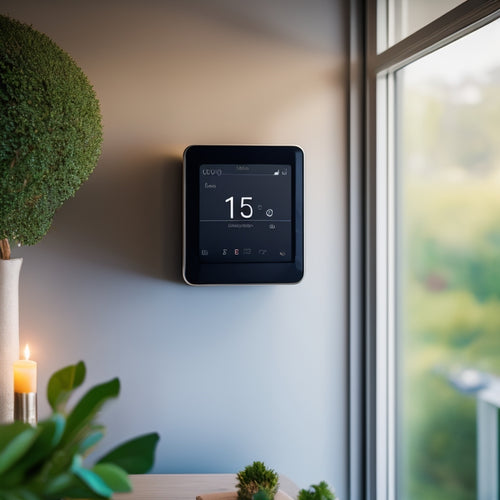
Top 10 Tips for Choosing Commercial Solar Kits
Share
You're about to invest in a commercial solar kit, and it's essential to get it right. Start by evaluating your energy requirements, tracking consumption, and optimizing energy use. Compare solar panel kit types, considering budget, installation constraints, and energy needs. Evaluate battery capacity, compatibility, and durability in harsh environments. Make sure seamless interaction with vehicle systems, and prioritize certifications and compliance. Consider warranty and support expectations, and budget for long-term savings. By weighing these factors, you'll be well on your way to choosing the right commercial solar kit for your needs - and that's just the beginning of your journey to harnessing the power of solar energy.
Key Takeaways
• Assess energy requirements and conduct load profiling to determine the necessary solar kit size and configuration.
• Consider the type of solar panel kit (grid tie, portable, or off-grid) based on energy needs, budget, and installation constraints.
• Evaluate battery capacity and technology, including Deep Cycle and Lithium-ion options, to ensure sufficient energy storage and efficient operation.
• Ensure compatibility and safety by verifying the seamless interaction of components and compliance with industry standards and regulations.
• Prioritize charge controller features, such as overcurrent protection and MPPT technology, to optimize energy harvesting and efficiency.
Assessing Your Energy Requirements
Determine your average daily energy consumption in watt-hours (Wh) by tracking your energy usage over a week or a month to get an accurate estimate of your energy needs. This is important in choosing the right commercial solar kit for your business.
To do this, you'll need to conduct a load profiling exercise, which involves monitoring your energy usage patterns to identify peak hours, energy-intensive appliances, and opportunities for energy efficiency. This exercise will help you identify areas where you can optimize energy consumption and reduce your overall energy requirements.
Conducting an energy audit is also vital in evaluating your energy requirements. An energy audit involves a thorough examination of your business's energy usage, including lighting, heating, ventilation, and air conditioning systems. This audit will help you identify energy-wasting areas and provide recommendations for improvement.
Solar Panel Kit Types Compared
Comparing different solar panel kit types is vital to finding the perfect fit for your business, as each type offers distinct advantages and disadvantages that can greatly impact your energy generation and savings.
You'll want to ponder the following key types of solar panel kits:
-
Grid Ties: These kits connect directly to the grid, allowing you to sell excess energy back to the utility company and offset your energy costs.
-
Portable Systems: Designed for temporary or remote installations, these kits are ideal for construction sites, outdoor events, or emergency backup power.
-
Off-Grid Systems: Suitable for areas without access to the grid, these kits provide reliable, standalone power generation.
When choosing a solar panel kit, it's essential to take into account factors like energy requirements, budget, and installation constraints.
Understanding Battery Capacity Needs
When sizing your commercial solar kit, you'll need to evaluate the right battery capacity to meet your energy needs.
To do this, you'll need to assess your daily energy requirements, the type of battery you're using, and the calculation method that works best for your system.
Calculation Methods Matter
You'll need to accurately calculate your battery capacity needs to guarantee your commercial solar kit can provide reliable power when the grid goes down. This calculation is vital to make sure your system can meet energy demands during an outage.
To get it right, consider the following calculation methods:
-
Peak Shaving: This method involves analyzing your energy usage patterns to identify peak hours and sizing your battery capacity accordingly.
-
Energy Modeling: This approach uses software to simulate your energy usage and predict your battery capacity needs.
-
Load Analysis: This method involves analyzing your facility's load requirements to determine the necessary battery capacity.
Battery Type Considerations
What type of battery is best suited to meet your commercial solar kit's unique energy demands?
When it comes to choosing the right battery type, you'll want to take into account your system's specific needs. For commercial solar kits, Deep Cycle batteries are a popular choice due to their ability to provide a steady flow of energy over an extended period. These batteries are designed to discharge deeply and recharge repeatedly, making them ideal for off-grid systems.
However, if you're looking for a more advanced option, Lithium-ion batteries are worth considering.
Lithium Options offer a higher energy density, longer lifespan, and faster charging capabilities compared to traditional Deep Cycle batteries. They're also more compact and lightweight, making them a great choice for commercial applications where space is limited.
When selecting a battery type, be sure to take into account factors such as depth of discharge, cycle life, and maintenance requirements to ensure you're getting the right fit for your commercial solar kit.
Daily Energy Requirements
To determine the ideal battery capacity for your commercial solar kit, you need to calculate your daily energy requirements. This involves evaluating the total amount of energy your system will consume during a 24-hour period. This calculation is important to make sure your solar kit can meet your energy demands and provide a reliable power supply.
To accurately determine your daily energy requirements, consider the following factors:
-
Peak energy usage: Identify the time of day when your energy consumption is highest, typically during peak business hours.
-
Energy-intensive appliances: Account for energy-hungry appliances, such as refrigeration units, HVAC systems, and industrial equipment.
-
Energy efficiency opportunities: Identify areas for improvement through Energy Audits and implement Energy Efficiency measures to reduce your overall energy consumption.
Compatibility With Vehicle Systems
When integrating a commercial solar kit into your vehicle's electrical system, it's crucial that the kit's electrical components seamlessly interact with your vehicle's existing systems. This guarantees safe and efficient energy harvesting and storage. Vehicle integration and electrical interoperability are critical considerations to prevent electrical shocks, fires, or other hazards.
To confirm compatibility, you should verify that the solar kit's electrical components meet your vehicle's electrical system requirements. Here's a summary of key considerations:
| Vehicle System | Solar Kit Component | Compatibility Check |
|---|---|---|
| Alternator | Charge Controller | Voltage, current, and communication protocols |
| Battery | Solar Panel | Voltage, capacity, and charging/discharging rates |
| Electrical Load | Inverter/Converter | Power output, frequency, and waveform |
| Wiring and Fuses | Solar Kit Wiring | Gauge, material, and fuse ratings |
| Monitoring System | Solar Kit Monitoring | Communication protocols and data formats |
Durability in Harsh Environments
How will your commercial solar kit hold up against the rigors of extreme temperatures, humidity, and physical stress, ensuring uninterrupted energy harvesting in harsh environments?
When selecting a commercial solar kit, it's important to take into account its durability in harsh environments. You want a kit that can withstand the test of time and harsh conditions, guaranteeing consistent energy production.
To guarantee your kit's durability, look for the following key features:
-
Rust resistance: A rust-resistant coating or material can protect your kit from corrosion, ensuring peak performance even in humid or coastal environments.
-
Extreme temperature tolerance: Your kit should be designed to operate efficiently in temperatures ranging from -20°C to 40°C (-4°F to 104°F), ensuring consistent energy production in various climates.
-
Physical stress resistance: A durable kit should be able to withstand physical stress, such as strong winds, hail, or other environmental stressors.
Efficient Charging System Design
When designing an efficient charging system, you'll need to take into account several key factors to guarantee peak performance.
First, you'll need to determine the right system size to meet your energy demands, taking into consideration variables like panel output and battery capacity.
From there, you can select the best charge controller option and design a battery bank that can store and supply power efficiently.
System Sizing Considerations
You'll need to determine the most suitable system size for your commercial solar kit by considering the energy requirements of your facility, as undersized systems can lead to energy shortfalls and oversized systems can result in unnecessary costs.
To guarantee peak energy optimization, consider the following key factors when sizing your system:
-
Peak energy demand: Calculate the maximum energy required by your facility during peak usage hours.
-
Energy storage needs: Determine the necessary battery capacity to secure a stable power supply during periods of low solar radiation or at night.
-
System complexity: Consider the complexity of your system, including the number of panels, inverters, and other components, to ensure efficient energy production and distribution.
Charge Controller Options
With your system size determined, it's time to focus on the efficient charging system design, starting with the charge controller options that will regulate the flow of energy from your solar panels to your battery bank.
As you explore charge controller options, prioritize essential overcurrent protection to prevent damage to your system. Look for controllers with built-in overcurrent protection features that can detect and respond to excessive currents.
Maximum power tracking (MPPT) is another vital feature to take into account. MPPT technology ensures your system operates at its peak potential, even in varying environmental conditions. This feature optimizes energy harvesting, reducing energy losses and increasing your system's overall efficiency.
When selecting a charge controller, make sure it has an MPPT algorithm that can adapt to changing solar irradiance and temperature.
Battery Bank Design
Battery Bank Design
To guarantee efficient charging system design, your battery bank design must accommodate the unique demands of your commercial solar kit, including the capacity to store excess energy generated during peak sunlight hours. A well-designed battery bank is essential to make sure your solar kit operates safely and efficiently.
To achieve this, consider the following key design elements:
-
Depth configuration: Ensure your battery bank is configured to accommodate the depth of discharge (DOD) required by your solar kit. A higher DOD requires more batteries, increasing overall system cost.
-
Cell balancing: Implement a cell balancing system to prevent overcharging or undercharging individual batteries, which can lead to premature failure.
-
Monitoring and maintenance: Regularly monitor your battery bank's performance and perform maintenance tasks, such as cleaning and inspecting connections, to ensure peak performance and extend its lifespan.
Monitoring and Maintenance Needs
Your solar kit's performance and longevity rely heavily on regular monitoring and maintenance to detect potential issues before they escalate into costly problems. You need to keep a close eye on your system's performance to make sure it's running efficiently and safely.
To make monitoring and maintenance more manageable, consider the following:
| Aspect | Frequency | Method |
|---|---|---|
| Real-time tracking | Ongoing | Remote monitoring software |
| Scheduled inspections | Quarterly | On-site visual inspection |
| Energy output analysis | Monthly | Data review and reporting |
| Inverter performance check | Bi-annually | On-site diagnostic testing |
| Cleaning and repair | As needed | Scheduled maintenance |
Certifications and Compliance Matters
When evaluating commercial solar kits, you'll need to take into account certifications and compliance matters.
You should look for kits that meet UL certification requirements, ensuring the equipment meets safety standards.
Additionally, verify that the kit complies with industry standards, such as those set by the International Electrotechnical Commission (IEC) or the Institute of Electrical and Electronics Engineers (IEEE).
UL Certification Requirements
The UL (Underwriters Laboratories) certification mark on a commercial solar kit indicates that the product has met rigorous safety standards, providing assurance that the system is safe for installation and operation. When selecting a commercial solar kit, you want to make sure that the product has undergone rigorous testing and meets the necessary standards. UL certification is an essential aspect to take into account, as it guarantees that the kit has been tested and certified to meet specific safety requirements.
Here are three key reasons why UL certification matters:
-
Safety assurance: UL certification ensures that the solar kit has been tested for safety, reducing the risk of electrical shock, fire, or other hazards.
-
Compliance with regulations: Many jurisdictions require UL certification for commercial solar installations, so choosing a certified kit ensures compliance with local regulations.
-
Peace of mind: With UL certification, you can have confidence that the solar kit has been thoroughly tested and meets the highest safety standards, giving you peace of mind for your investment.
Industry Standards Compliance
In addition to UL certification, you need to verify that your commercial solar kit complies with industry standards, which encompass a broader range of certifications and compliance matters that impact the overall performance and safety of your solar installation.
When evaluating industry standards compliance, you should look for certifications from reputable organizations, such as the International Electrotechnical Commission (IEC) and the Institute of Electrical and Electronics Engineers (IEEE). These organizations establish standards for the design, installation, and operation of solar systems.
Moreover, you should confirm that your commercial solar kit complies with local and national regulations, including code enforcement and permitting requirements. This includes adhering to the National Electric Code (NEC) and local building codes, as well as obtaining necessary permits and approvals from regulatory authorities.
Warranty and Support Expectations
You should expect a thorough warranty and dedicated support from your commercial solar kit provider, considering the significant investment you're making in renewable energy. After all, a reliable warranty and responsive customer service can make all the difference in securing your system operates efficiently and safely.
Here are three key aspects to look for in a commercial solar kit provider's warranty and support:
-
Manufacturer guarantees: Make sure the provider offers a detailed warranty that covers the solar panels, inverters, and other components for a reasonable period, typically 10-25 years.
-
Customer service: Seek 24/7 technical support, online resources, and a dedicated customer service team that can assist with any issues or concerns.
-
Regular maintenance and monitoring: Opt for a provider that offers regular system checks, performance monitoring, and proactive maintenance to prevent potential issues.
Budgeting for Long-Term Savings
By allocating a dedicated budget for your commercial solar kit, you'll be investing in long-term savings that can greatly offset your energy costs. It's crucial to set a realistic financial goal, considering the initial investment and ongoing expenses.
A thorough cost analysis will help you understand the total cost of ownership, including installation, maintenance, and potential upgrades.
When creating your budget, consider the system's size, quality, and efficiency. Higher-efficiency systems may cost more upfront but provide greater long-term savings. Additionally, factor in local incentives, such as tax credits or rebates, which can greatly reduce your upfront costs.
Be sure to also account for ongoing expenses, like maintenance and repairs, to make sure you're prepared for any unexpected costs.
Frequently Asked Questions
Can I Mix and Match Components From Different Manufacturers?
When mixing and matching components from different manufacturers, you'll encounter compatibility risks and potential warranty implications, so it's vital to guarantee seamless integration and verify warranty terms to avoid costly surprises down the line.
Are There Any Government Incentives for Commercial Solar Adoption?
You'll be relieved to know that, yes, government incentives exist for commercial solar adoption! You can snag Tax Credits and Renewable Grants to offset system costs, making your investment even more lucrative.
How Do I Ensure Compliance With Local Building Codes and Regulations?
You guarantee compliance with local building codes and regulations by undergoing code compliance training and following the permit application process, securing a safe and legally approved commercial solar installation.
Can I Add More Panels to My System in the Future if Needed?
"When you invest in a scalable system, like the 500 kW installation at California's Santa Clara Valley Medical Center, you can easily add more panels in the future, ensuring you're futureproofed and ready for growing energy demands."
Are Commercial Solar Kits Compatible With Generators or Other Power Sources?
You can integrate commercial solar kits with generators or other power sources, creating off-grid systems that provide power redundancy, ensuring a reliable and safe energy supply, even during outages or emergencies.
Related Posts
-

Smart Energy: Greener Homes With Connected Power Devices
You can control and optimize your energy consumption with smart energy devices, reducing your carbon footprint by up ...
-

7 Top HEPA Filters for Green Building Projects
You need a reliable HEPA filter for your green building project that aligns with your sustainable goals and guarantee...
-

What Air Purifiers Save Energy in Work Areas?
You can cut energy costs and reduce your carbon footprint by choosing air purifiers designed with energy efficiency i...


